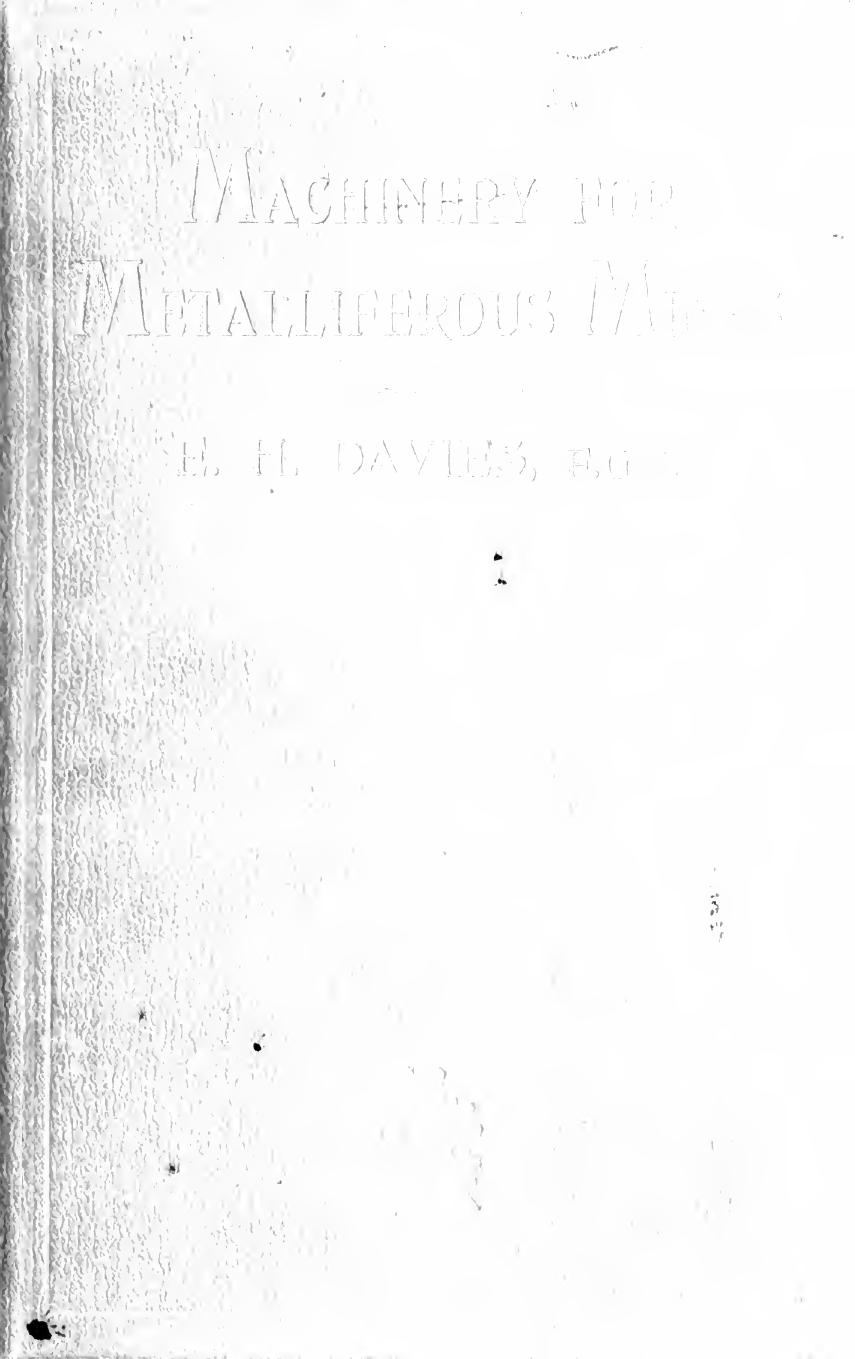Machinery for metalliferous mines : a practical treatise for mining engineers, metallurgists and managers of mines by Davies E. Henry (Edward Henry)

Author:Davies, E. Henry (Edward Henry)
Language: eng
Format: epub, pdf
Tags: Mining machinery
Publisher: London : Crosby Lockwood ; New York : Van Nostrand
Published: 1902-03-25T05:00:00+00:00
THE WORKING OF JIGGERS.
295
to time by the removal of a plug in the bottom. The compartment in which the pistons work is covered with a board (0) to prevent the violent splashing of the water, and is lined with thin boards, which take up the wear, and save the permanent sides of the machine. In the ordinary Hartz jigger the hutch or jigger box is 3 ft. 6 in. deep, and the size of the sieves 2 ft. 4 in. x i ft. 6 in.
The Working of Jiggers.—The object in dividing the jigger into a number of compartments is in order to obtain two or more products, as, for instance, when the ore contains both galena and blende the same jigger will effect their separation from each other, and the sterile gangue giving also a mixed product containing both the minerals, which must be sent back to be recrushed. The stroke of the piston of each compartment is regulated according to the work to be done; and for the same reason the composition of the " bed " of the jigger varies on each of the sieves. The speed also of each machine is varied according to the size of the material, the rule being the coarser the mineral the slower the speed, so that the speed will vary from 60 strokes per minute for 10 mm. stuff up to 300 strokes for the jiggers treating the fine sands from the classifiers. The speed at which the jigger is to run is decided upon when the mill is designed, but the stroke is adjusted by the foreman dresser or manager, according to the
mineral under treatment, and the amount of enrichment which it is desired to give to the ore. As a general rule, the length of the stroke must be sufficient to lift the ore through a height equal to the diameter of the grains, and the time between the strokes must be sufficient to allow the grains to settle. The end sought after is a stroke which will be just sufficient to lift up and open the bed of the jigger, and allow the rich grains of mineral to pass through ; while, at the same time, it drives off the lighter and poorer mineral into the next compartment.
If the stroke is too great it drives the rich ore over, and the steriles contain too high a percentage of metal; on the other hand, if it is not enough, the poor stuff falls through with the rich, and the percentage of metal in the concentrates goes down.
The following table will give an approximate idea of the length ol stroke and speed appropriate to jiggers treating ore from 10 mm. down to 3- mm. diameter. These figures, however, give only general dimensions, for practice with the kind of ore under treatment is the only
Download
Machinery for metalliferous mines : a practical treatise for mining engineers, metallurgists and managers of mines by Davies E. Henry (Edward Henry).pdf
This site does not store any files on its server. We only index and link to content provided by other sites. Please contact the content providers to delete copyright contents if any and email us, we'll remove relevant links or contents immediately.
| Automotive | Engineering |
| Transportation |
Whiskies Galore by Ian Buxton(41712)
Introduction to Aircraft Design (Cambridge Aerospace Series) by John P. Fielding(33011)
Small Unmanned Fixed-wing Aircraft Design by Andrew J. Keane Andras Sobester James P. Scanlan & András Sóbester & James P. Scanlan(32678)
Craft Beer for the Homebrewer by Michael Agnew(18076)
Turbulence by E. J. Noyes(7888)
The Complete Stick Figure Physics Tutorials by Allen Sarah(7258)
Kaplan MCAT General Chemistry Review by Kaplan(6813)
The Thirst by Nesbo Jo(6748)
Bad Blood by John Carreyrou(6468)
Modelling of Convective Heat and Mass Transfer in Rotating Flows by Igor V. Shevchuk(6349)
Learning SQL by Alan Beaulieu(6152)
Weapons of Math Destruction by Cathy O'Neil(6076)
Man-made Catastrophes and Risk Information Concealment by Dmitry Chernov & Didier Sornette(5870)
Digital Minimalism by Cal Newport;(5576)
Life 3.0: Being Human in the Age of Artificial Intelligence by Tegmark Max(5397)
iGen by Jean M. Twenge(5294)
Secrets of Antigravity Propulsion: Tesla, UFOs, and Classified Aerospace Technology by Ph.D. Paul A. Laviolette(5232)
Design of Trajectory Optimization Approach for Space Maneuver Vehicle Skip Entry Problems by Runqi Chai & Al Savvaris & Antonios Tsourdos & Senchun Chai(4949)
Electronic Devices & Circuits by Jacob Millman & Christos C. Halkias(4859)
